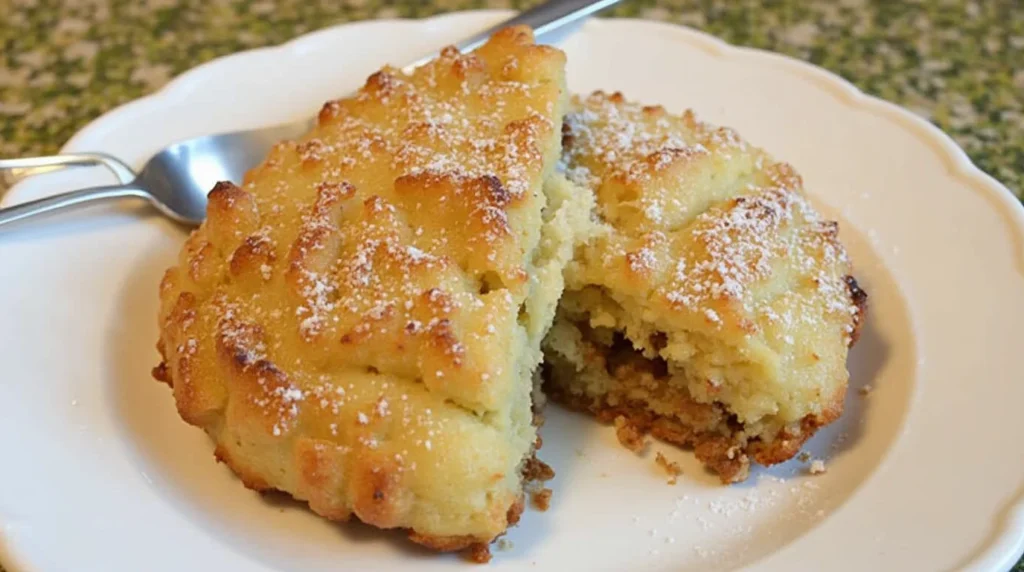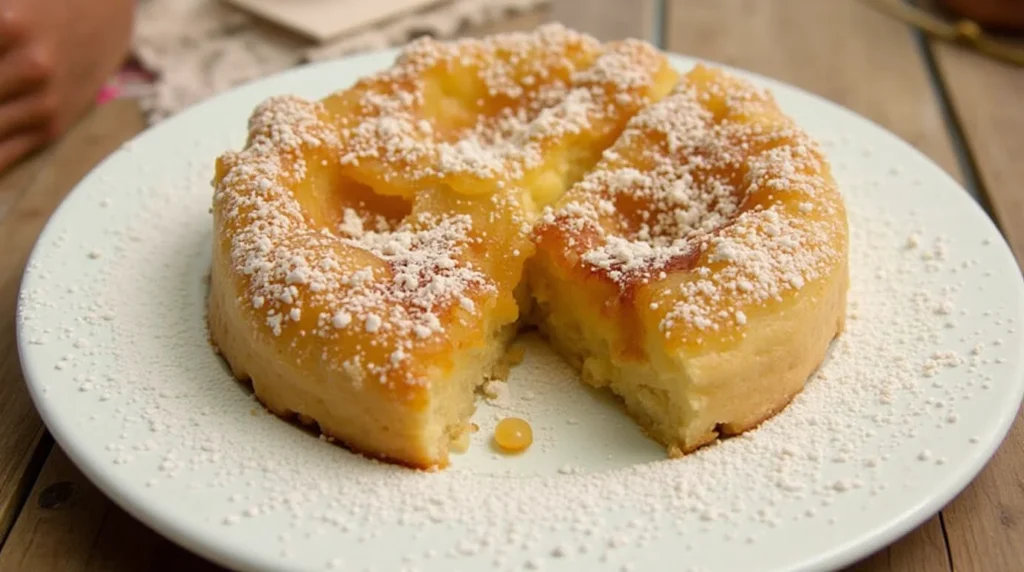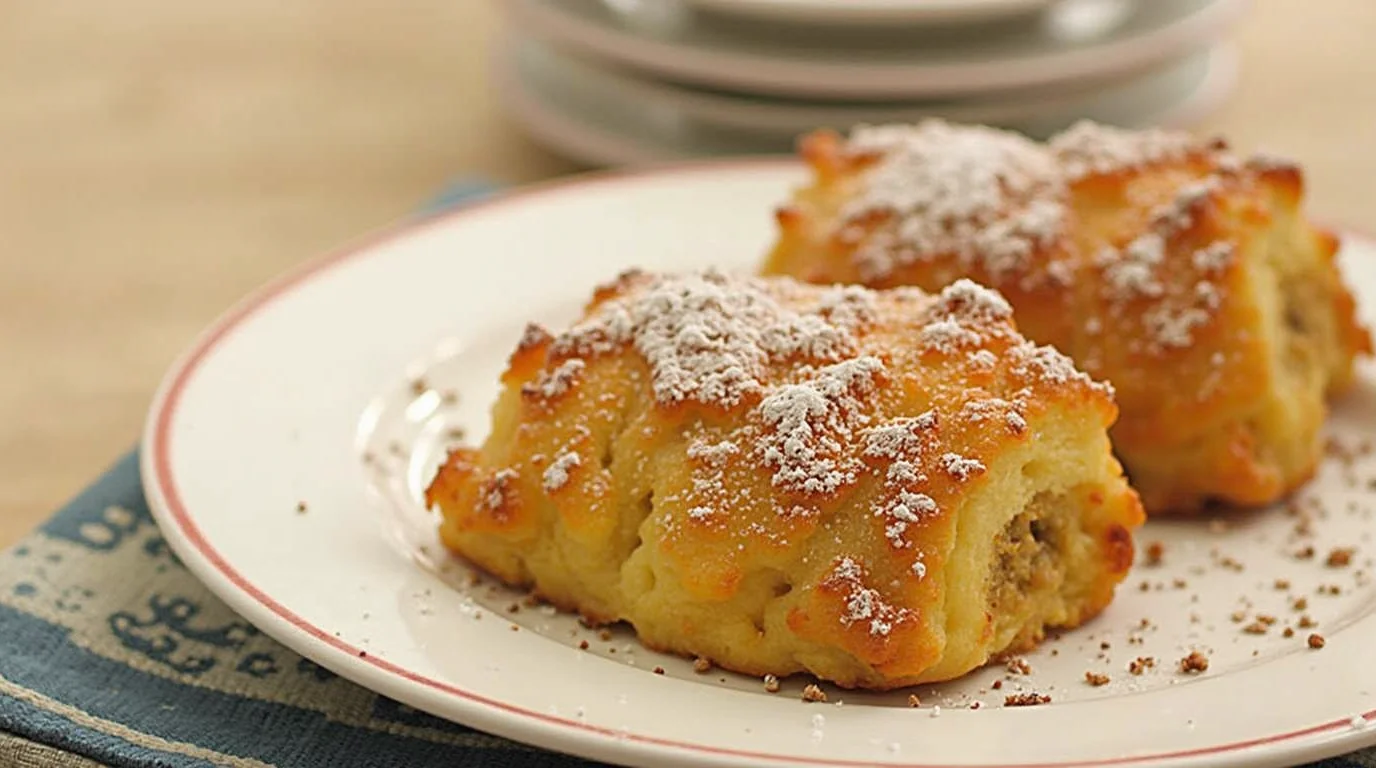Table of Contents
Introduction to Gipfeli
History and Origin of Gipfeli
Gipfeli, a beloved pastry in Switzerland, traces its origins to Central Europe, where crescent-shaped baked goods have been enjoyed for centuries. The term “Gipfeli” is derived from the German word “Gipfel,” meaning “peak” or “summit,” which symbolizes the crescent shape of the pastry. While its form resembles the more globally recognized croissant, Gipfeli is uniquely Swiss, often less buttery and lighter in texture. Traditionally, Gipfeli was a staple in Swiss bakeries and became a breakfast classic, paired with coffee or hot chocolate. Its versatility has made it a cherished item, now enjoyed in both sweet and savory variations.
Difference Between Gipfeli and Croissants
Though similar in appearance, Gipfeli and croissants differ in several ways. Gipfeli typically contains less butter, making it less rich and more compact than the flaky, layered croissant. The dough for Gipfeli is slightly firmer and less laminated, resulting in a texture that’s closer to bread than pastry. While croissants are widely associated with French cuisine and often served as a decadent treat, Gipfeli embodies a more modest Swiss approach, focusing on simplicity and everyday enjoyment. Additionally, Gipfeli often comes in savory variations, such as ham and cheese, alongside its sweeter counterparts.

Ingredients for Gipfeli
List of Essential Ingredients
To prepare Gipfeli, you’ll need a few fundamental ingredients commonly found in most kitchens. The base requires all-purpose flour, which provides structure, and unsalted butter to create the characteristic richness. Milk or water is used for hydration, while yeast acts as the leavening agent, giving the pastry its soft, airy texture. A small amount of sugar enhances the flavor, and salt balances the taste. For an appealing golden crust, you’ll need an egg wash. These simple ingredients come together to create a versatile dough that can be customized for various Gipfeli styles.
Variations in Ingredients for Sweet and Savory Gipfeli
For sweet Gipfeli, consider adding vanilla extract, honey, or a touch of cinnamon to the dough. Fillings such as chocolate, fruit jam, or almond paste can be incorporated for a decadent twist. For savory Gipfeli, the dough can include a pinch of herbs or cheese for added flavor. Popular savory fillings include ham and cheese, spinach and feta, or even mushroom and onion. These variations allow you to tailor the recipe to your preferences, making Gipfeli a versatile choice for any time of the day.

Step-by-Step Instructions for Making Gipfeli
Preparing the Dough
To begin, gather your ingredients: flour, sugar, salt, yeast, milk, and butter. In a large mixing bowl, combine the flour, sugar, and salt. In a separate bowl, warm the milk to a lukewarm temperature and dissolve the yeast in it. Allow the mixture to sit for about 5–10 minutes until it becomes frothy, indicating that the yeast is active. Gradually add the milk and yeast mixture to the dry ingredients, mixing until a dough forms. Knead the dough on a floured surface for 8–10 minutes until it becomes smooth and elastic. Shape it into a ball, place it in a lightly oiled bowl, and cover with a damp cloth. Let the dough rise in a warm place for 1–2 hours or until it doubles in size.
Laminating the Dough for Layers
Once the dough has risen, roll it out on a floured surface into a rectangular shape. Place chilled butter (flattened into a thin, even sheet) on two-thirds of the dough. Fold the uncovered third of the dough over the butter, then fold the remaining third on top, similar to folding a letter. Rotate the dough 90 degrees, roll it out again, and repeat the folding process two to three more times, chilling the dough for 20–30 minutes between folds. This process, known as lamination, creates the layers that make Gipfeli light and slightly flaky.
Shaping and Filling the Gipfeli
After laminating, roll the dough into a thin rectangular sheet. Use a sharp knife or a pastry cutter to divide the dough into triangles. For traditional Gipfeli, leave the dough plain, or for filled versions, add a small amount of filling, such as jam or cheese, to the base of each triangle. Starting from the base, roll each triangle tightly towards the tip to create the crescent shape. Ensure the tip is tucked underneath to prevent unrolling during baking.
Baking to Perfection
Preheat your oven to 375°F (190°C). Place the shaped Gipfeli on a parchment-lined baking tray, leaving enough space between them to rise during baking. Brush each pastry with an egg wash for a golden, shiny finish. Bake the Gipfeli for 15–20 minutes or until they are golden brown and puffed. Keep a close eye on them during the last few minutes to avoid overbaking. Once done, remove from the oven and let them cool slightly on a wire rack before serving. Enjoy them warm with your favorite beverage!
Tips and Tricks for the Perfect Gipfeli
How to Achieve Flaky Layers
The key to achieving beautifully flaky layers lies in proper lamination. Use cold, high-quality butter and chill the dough between folds to keep the butter from melting into the dough. Roll the dough evenly and avoid pressing too hard to maintain distinct layers. Use a sharp knife for cutting to prevent squishing the laminated structure. Patience is essential—ensure the dough rests adequately during each chill cycle to allow gluten to relax, making it easier to work with and improving the final texture.
Common Mistakes to Avoid
Avoid using melted or softened butter during lamination, as this can result in dense, greasy Gipfeli. Overworking the dough can make it tough and compromise the layers, so handle it gently. Ensure the oven is preheated to the correct temperature before baking; too low a temperature will cause the butter to leak out instead of creating steam for puffing. Lastly, do not overfill the triangles, as the filling may leak out, leaving the pastry soggy and uneven.
Storage and Reheating Tips
Store leftover Gipfeli in an airtight container at room temperature for up to two days. For longer storage, freeze them in a single layer on a baking sheet, then transfer them to a freezer-safe bag. Reheat frozen Gipfeli in a preheated oven at 350°F (175°C) for 10–15 minutes to restore their crispiness. Avoid microwaving, as this can make them soft and chewy instead of flaky.
Popular Variations of Gipfeli
Sweet Versions: Chocolate, Jam-Filled, and More
Sweet Gipfeli variations are a delight for those with a sweet tooth. One of the most popular options is chocolate-filled Gipfeli, where a small piece of dark or milk chocolate is placed inside the dough before rolling. Jam-filled Gipfeli are another classic, with fillings such as apricot, raspberry, or plum preserves adding a fruity burst of flavor. For a richer twist, you can use almond paste or a dollop of hazelnut spread. To enhance the sweetness, some recipes call for sprinkling the tops with coarse sugar or glazing with a light sugar syrup after baking. For added texture, a sprinkle of slivered almonds or powdered sugar can make the pastry even more appealing. Sweet Gipfeli are perfect as a breakfast treat or a dessert.
Savory Versions: Cheese, Ham, and Vegetable Fillings
Savory Gipfeli are equally popular, offering a hearty and satisfying snack or meal option. Cheese-filled Gipfeli are a favorite, with varieties like Swiss cheese, Gruyère, or cream cheese providing a creamy and savory interior. Ham and cheese Gipfeli combine two classic flavors and are ideal for brunch. For a vegetarian twist, fillings such as spinach and feta, roasted vegetables, or even mushrooms and caramelized onions add depth and variety. Some recipes also incorporate herbs like thyme or oregano into the dough for an extra layer of flavor. These savory versions are perfect for on-the-go meals, picnics, or even as appetizers at gatherings.
Serving Suggestions
Best Pairings for Gipfeli
Gipfeli pairs beautifully with a variety of beverages and breakfast sides. For a classic Swiss breakfast, enjoy them with a steaming cup of coffee, espresso, or cappuccino. If you prefer something lighter, herbal tea or hot chocolate complements the pastry’s delicate flavors. Sweet Gipfeli pair well with a side of fresh fruit or yogurt, while savory versions shine alongside a mixed salad, scrambled eggs, or a cheese platter. For a luxurious touch, serve with small bowls of butter, fruit preserves, or cream cheese to enhance the flavors.
Presentation Ideas for Special Occasions
For a festive touch, arrange Gipfeli on a tiered serving tray alongside small bowls of dips or spreads. Garnish sweet Gipfeli with a dusting of powdered sugar or a drizzle of chocolate sauce. For savory options, consider sprinkling with fresh herbs like parsley or thyme. You can also wrap individual Gipfeli in decorative parchment paper tied with twine for an elegant touch at brunch events or picnics. For themed gatherings, offer a mix of sweet and savory Gipfeli in separate baskets to cater to all tastes.
FAQs about Gipfeli Recipe
What is the difference between Gipfeli and a croissant?
Gipfeli and croissants differ in texture and richness. Gipfeli contains less butter, resulting in a less flaky and more compact structure compared to the rich, airy layers of a croissant. Additionally, Gipfeli is often simpler and comes in savory versions, while croissants are typically more decadent and associated with French cuisine.
Can I make Gipfeli without yeast?
Yes, you can make Gipfeli without yeast by using baking powder or self-rising flour as a leavening agent. While the texture won’t be as light and airy as traditional Gipfeli, the result will still be a delicious pastry with a slightly denser consistency.
How long does it take to prepare Gipfeli?
Preparing Gipfeli typically takes 2–3 hours, including the time for making the dough, laminating it, and allowing it to rise. The baking process adds another 15–20 minutes. For beginners, it may take slightly longer, but the process becomes quicker with practice.
Can I freeze Gipfeli dough for later use?
Yes, Gipfeli dough freezes well. After laminating and shaping the dough, place it on a baking sheet and freeze until solid. Transfer to an airtight container or freezer bag. When ready to use, thaw in the refrigerator overnight before baking as usual.
What fillings work best for savory Gipfeli?
Popular fillings for savory Gipfeli include cheese (e.g., Gruyère or cream cheese), ham, spinach and feta, mushrooms, and caramelized onions. You can also experiment with roasted vegetables, smoked salmon, or herbs for a flavorful and satisfying twist.
Nutritional Information
Caloric Breakdown of Standard Gipfeli
A standard Gipfeli typically contains around 250–300 calories per serving, depending on its size and ingredients. The majority of calories come from the butter and flour, providing fat and carbohydrates, while protein is derived from the small amount of milk or eggs used in the dough. Sweet versions, especially those with fillings like chocolate or jam, tend to have a higher sugar content, while savory Gipfeli with cheese or ham may have slightly more fat and protein. These factors make Gipfeli a satisfying treat but best enjoyed in moderation as part of a balanced diet.
Nutritional Adjustments for Healthier Versions
To create a healthier Gipfeli, consider substituting whole wheat flour for part of the all-purpose flour to increase fiber content. Use low-fat butter or margarine to reduce fat, and opt for natural sweeteners like honey or maple syrup instead of refined sugar. For savory versions, replace high-fat fillings with options like low-fat cheese, vegetables, or lean meats. Baking smaller, portion-controlled Gipfeli can also help manage calorie intake. These adjustments allow you to enjoy the same delicious pastry with added nutritional benefits.
Conclusion
Gipfeli is a versatile and delightful pastry that brings a taste of Swiss tradition to your table. With its simple ingredients and customizable nature, it can be enjoyed in both sweet and savory forms, making it suitable for breakfast, brunch, or a comforting snack. The process of preparing Gipfeli, from kneading and laminating the dough to shaping and baking, is a rewarding culinary experience. By following the step-by-step instructions and incorporating tips for flaky layers, you can create a pastry that is both visually appealing and delicious.
Pair your homemade Gipfeli with breakfast classics like the Perfect French Toast Guide or complement it with Perfect Scrambled Eggs for a hearty start to your day. For a sweeter touch, consider serving alongside recipes like Classic Fluffy Pancakes or the irresistible Banana Pancakes Recipe. If savory brunch ideas excite you, explore hearty dishes like the Best Meat Loaf Recipes for inspiration.
Now that you’ve learned how to make Gipfeli, why not give it a try? With a bit of practice, you’ll master the art of crafting this delightful pastry, impressing your family and friends with your baking skills. So roll up your sleeves, preheat your oven, and savor the joy of homemade Gipfeli fresh from your kitchen.

